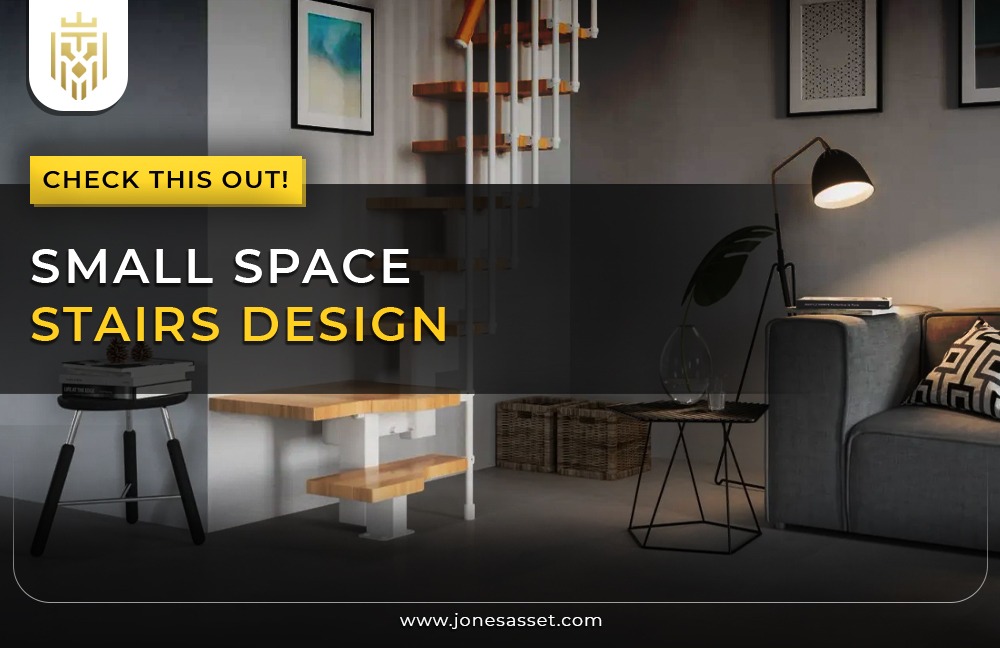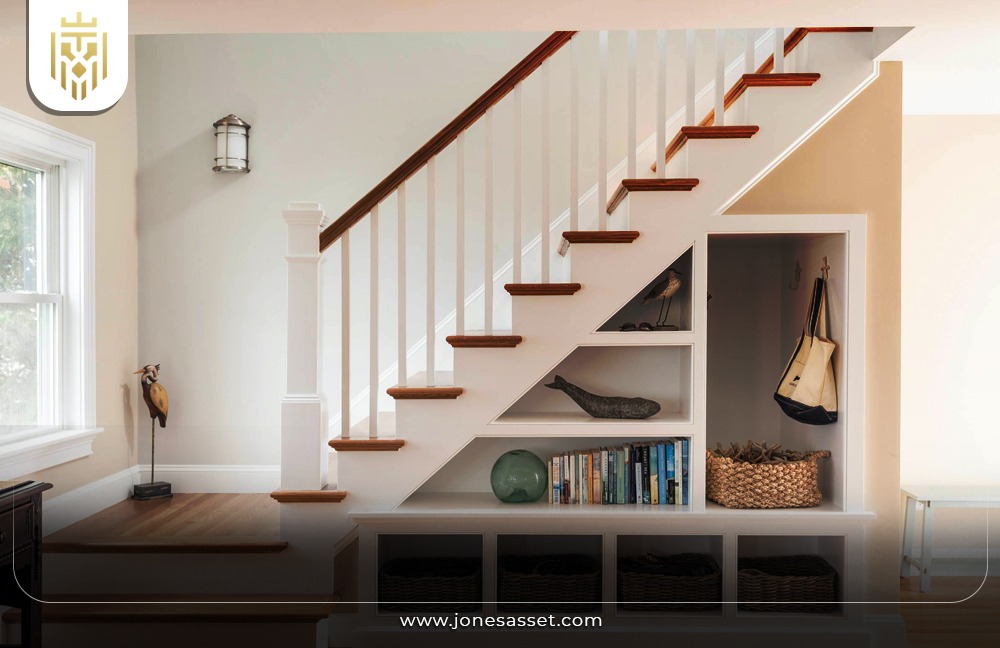Space-saving stairs design for small space:
Space-saving stairs are the smaller design solutions for small areas that are useful for vertical space without losing functionality or safety. They propose groundbreaking solutions to usability in constrained environments, thus, they are perfect for tiny homes, lofts, or apartments with a small area to live.
Things to consider when choosing a small space staircase design:
Factors such as space dimensions, architectural style, safety regulations, material durability, ease of installation, and aesthetic preferences should be the main criteria when choosing the ideal small space stairs design. Besides, the fact that the staircase is an integral part of the design and functionality of the space is essential for a well-balanced result.
Types of staircase home designs:
Staircase designs are different to fit the space requirements and aesthetic taste, and we shall be going through some of them:
Spiral Staircase Design:
Spiral staircases are characterized by a helical structure that is spiraling around a central axis, thus providing a compact footprint and an elegant aesthetic. They are flexible, can be fitted into small spaces with ease, and are available in different materials and designs that can match different interior styles. Spiral staircases are very good at saving space but they have some drawbacks like the accessibility and the furniture moving because of their narrow treads.
Open Staircase Design:
Open staircases have a minimalist design with open risers and no support structures, thus, creating a feeling of lightness and an attractive look. They enhance the natural light flow and create a spacious atmosphere, which makes them perfect for modern and contemporary interiors. Nevertheless, open staircases may need to be monitored carefully, especially in families with kids or pets.
Hanging Staircase design:
Hanging staircases, which are also called floating staircases, are hung from the ceiling or the wall, thus they create a beautiful visual effect and the impression of floating steps. They are a modern and distinctive way of designing and at the same time, they save floor space. However, hanging staircases need structural support and careful installation to be safe and stable, so professional advice is necessary for their implementation.

Cubic staircase design:
Cubic staircase design is characterized by geometric shapes and clean lines, which make up a modern and minimalist aesthetic. Cubic staircases are the perfect addition to modern interiors as they provide a contemporary and bold design for the stairs. Nevertheless, they might need attention to detail to ensure comfortable and safe usability, especially taking into account the sharp angles and the lack of traditional railing.
Swirling staircase design:
The staircase design is a swirling, curved, or helical structure that spirals gracefully, and thus, a beautiful and dynamic focal point is created within a space. The design of this product is a way that it looks like it is moving, which makes it more interesting to look at, and at the same time, it saves space. Staircases that are swirling are usually made to suit the particular spatial needs and the design likes of the owner, thus, they become a unique and fascinating architectural feature. Nevertheless, the creation of curved stairs may be more complicated and expensive than the standard straight ones.
Staircase design without railing:
Open riser staircases, which are also called staircase designs without a railing, are the ones that have the treads exposed without the usual railing. This extremely simple way makes the room look spacious and clear, at the same time, it connects the room with the outside world, hence the room is very well lit and the space is also maximized. While the staircases without railings are quite modern and sleek, they may not be appropriate for all settings, for instance, in households with young children or people with mobility issues.
L-Shaped Staircase Design:
The L-shaped staircase design has a configuration that bends at a 90-degree angle, looking like the letter “L. ” This flexible layout can be used efficiently and can fit different architectural styles. L-shaped staircases are flexible in terms of placement and design, thus, they are suitable for both small and large spaces. Moreover, they act as a bridge between the levels while at the same time, they make the interior environment more attractive. Nevertheless, strict adherence to the building codes and safety regulations is crucial during the design and construction process.
Materials for your staircase design:
Staircases can be manufactured from different materials for instance, wood, metal, glass, and concrete. Each material brings its characteristic quality of aesthetics and structure to the table which in turn paves the way for the architects to have unlimited design options that will go with different architectural styles and interior choices.
Wooden staircase design:
A wooden staircase, in its gentle curves and natural splendor, provides a sense of warmth and beauty. It’s very versatile and allows you to match it with different interior styles, starting with classic and finishing with modern. The wooden stairs are robust, and they can be stained or painted to match the preferred shade of the colors.
Metal staircase design:
The metal staircase design is sleek and contemporary, giving a modern look. It gives strength and durability to the design and also makes it possible to create minimalistic and delicate designs. The metal stairs can be made of materials such as steel, aluminum, or wrought iron and this offers variety in style and finish.
Glass staircase design:
Glass stairs decorate the interiors with a feeling of openness and classiness. It brings a lot of natural light to the room and creates a harmonious, modern look for the interiors. Frosted glass stairs that are reinforced with either tempered or laminated glass for safety and durability, are a visual focal point in both residential and commercial buildings.
Concrete and Staircase Design:
Concrete staircase design can provide a minimalist and industrial aesthetic. It is resistant to wear and tear, and flames, and it can be used both inside and outside. Similarly, concrete steps can be cast in place or prefabricated; the former allows for a variety of finishes and textures to match the overall design idea.
Modern Staircase Design Ideas:
Today’s staircases are not just functional; they have been reimagined with cutting-edge designs that make them visually appealing as well. Suggestions include floating stairs, architect-designed staircases, loft ladders, and spiral staircases, all of which have the potential to complement and improve the overall look of the interior space as well as the functionality and style.
Floating Stairs:
Floating stairs are a visually striking design solution that makes for a look of stairs that are floating in the air with little visible support in the interiors. They brighten up and bring an airy effect to the room, and also allow for some innovative architectural design. The flights of stairs which are not fixed can be made of several materials, such as wood, metal, or glass. This, in turn, creates numerous design options.
Sculptured Staircases:
The sculpture staircases are adorned with elaborate and artistic designs that make them not just a functional element but also a sculptural component of the space. These flights of stairs are usually designed to have organic shapes, curves, and unique detailing to draw the attention of the viewers. Sculptured staircases are a chance to unleash the artist in all of us and can turn into a marvelous decorative element.
Loft Ladders:
Loft ladders are a means to get to above-head spaces like lofts, mezzanines, or attic areas. In most cases, they are collapsible and portable providing ease of use and a compact storage space in small rooms. Loft ladders inhabit a range of designs including retractable, sliding, and telescoping types, which not only provide accessibility but also enhance the interior design.
Spiral Staircases:
Spiral staircases are an architectural feature that has a helical structure, which revolves around a central axis and they offer a compact footprint and a sophisticated look. They are flexible enough to serve both indoor and outdoor purposes, therefore, they can be used to fill tight spaces or act as an architectural element. Spiral staircases are created in different materials and styles to match the design personalities of the different homeowners.
Under Staircase Space Design Ideas:
The space beneath the stairs can be utilized creatively so that it can be useful and also blend with the interior design of your home. There are various creative ideas, including the bookshelf design, pet-friendly storage, kitchen concepts, the pullout drawer, and hidden closets, that can optimize the usage of this frequently ignored area, and, at the same time, bring style and functionality to the space that you live in.
Bookshelf Design Under Stairs:
Change the space under the stairs into a trendy and utilitarian bookshelf. The bookcase should be customized with shelves that can hold books, decorative items, and personal items and the vertical space should be optimized. This will make the area more attractive.
Pet-Friendly Under Stairs Storage Design Ideas:
Design a pet-friendly area under the stairs by including built-in feeders, comfy sleeping spots, and built-in storage space that can be used to store pet supplies. This solution to the design problem guarantees that your little pets have their specific zone that is organized and clutter-free at the same time.
Kitchen Ideas for Under Your Stairs:
Use the small space under the stairs to create a mini-kitchen or pantry with compact fixtures. Maximize the storage capacity within the area by using it to keep kitchen essentials, appliances, and cookware, a must-have in small homes and apartments where space is a concern.
Pullout Drawers Under Stairs:
Support pull-out compartments under stairs to achieve the highest storage capacity and ease of use. These pull-out units are adaptable and can be configured to store different objects including shoes, clothes, or household items, making it possible to have an efficient organization and quick retrieval of these items.
Hidden Closet Under The Stairs:
Hide a closet under the stairs for convenient storage of coats, shoes, cleaning supplies, and seasonal items, which you can easily access without going to the main closet. As for the hidden doors or sliding panels, they can be taken into account to keep a minimized and beautiful look while making the most of the available space.
Conclusion:
To wrap up, the small space staircase design is a mix of creativity and practicality that helps to create functional solutions for the vertical space and at the same time improve the indoor’s aesthetic. Through the selection of suitable materials, the incorporation of a layout, and the integration of storage functionality, homeowners can develop stylish and functional staircases that are designed to satisfy their specific needs.
FAQs
Which staircase is best for small spaces?
The best staircase for small spaces depends on the specific needs and constraints of the area. Generally, space-saving options like spiral staircases, compact L-shaped stairs, or floating stairs are suitable choices for optimizing vertical space while maintaining functionality and aesthetics.
How to make stairs in a small space?
To make stairs in a small space, consider space-saving designs like spiral staircases, which have a compact footprint. Additionally, explore custom-built options tailored to fit the dimensions and style of the area, ensuring efficient utilization of space without compromising safety or aesthetics.
How to fit a case in a small space?
Fitting a staircase in a small space requires careful planning and consideration of space-saving designs. Options like spiral staircases or custom-built stairs can be tailored to fit the available dimensions while maximizing vertical space. Consulting with a professional designer or architect can help create a staircase solution that meets both functional and aesthetic requirements.






